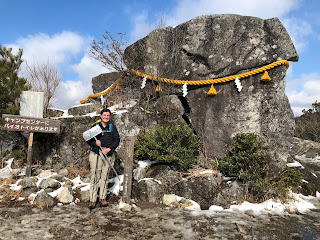For my last post of the year, and my last in the 20-teens, I'm taking you into the future . . . for a look at two of my (many) favorite Japanese traditions:
 |
| Kamado Jinja, in Kyushu, just after New Year 2019 |
Joya no Kane (除夜の鐘) and Hatsumode (初詣)
In Japan, New Year's Eve is not customarily celebrated with Bacchanalian revels and confetti. Instead, most people spend the evening at home (or eating out) with family, preparing to welcome the New Year--and all the potential promises it holds.
 |
| Sensoji, Tokyo's oldest Buddhist temple |
As midnight approaches, people flood into the grounds of Buddhist temples across Japan. Precisely at midnight, the priests begin to run the enormous bronze bell(s) on the temple grounds. Each bell is run 108 times - one for each of the passions and desires that Buddhists believe bind people to this world, and prevent us from reaching enlightenment. The ringing also creates a bridge between the old year and the new.
Attending joya no kane is said to bring good fortune, and good health, in the year to come. It is also one of the many sacred rituals that mark the passage of time, the seasons, and life here in Japan.
 |
| One of many bells that will welcome the new year |
On New Year's morning, Japanese families flock to Shinto shrines (and Buddhist temples) for hatsumode, the first shrine visit of the New Year. Since January 1, 2, and 3 are holidays here in Japan, some people also visit on January 2 or 3 (and people actually make hatsumode visits to shrines and temples throughout the month of January, though traditionally you're supposed to do it during the first few days of the new year.)
 |
| Kamado Jinja, dressed in a fresh coat of snow for New Year |
Most shrines offer special goshuin--stamps and calligraphy, placed in a special book called a goshuincho--on New Year's day, as well as hamaya, or "demon breaking arrows."
 |
| My hamaya from 2019 - the year of the Boar |
Purchasing a hamaya, and displaying it in your home, is supposed to provide protection for your house and family during the year to come. The following January, you return the arrow to the shrine, where it is burned in a sacred fire.
Many shrines are located at the base of mountains; in most cases, there is also a shrine on the mountaintop.
 |
| Kamado Jinja, atop Mt. Homanzan |
Those of us who like to climb will often make our hatsumode visit to a mountain shrine, and climb to the top before getting our goshuin and hamaya.
 |
| A beautiful January morning on Mt. Homanzan |
(There are a lot more people on the mountains in winter than you might think, though the vast majority do stay at the bottom.)
 |
| Happy New Year 2019! |
This year's joya no kane and hatsumode will be particularly meaningful, as we send out 2019 and welcome 2020--the start of a whole new decade.
 |
| Ready to welcome 2020 - the year of the Mouse! |
As it happens, they will have particular meaning for my family, because my parents, as well as my brother and his wife, are coming to spend the holidays in Japan, which means that--in accordance with Japanese tradition--I will have my entire extended family with me to welcome the New Year.
 |
| (Me, waiting for my family...) |
I wish each and every one of you a happy, blessed and bright New Year, wherever you are and whatever your traditions.
What are your plans to welcome 2020?















Barbara and I wish you and your wonderful family the happiest and healthiest of New Years in your adopted homeland! Barbara and I will be spending the time in Scottsdale...recovering from our wedding. Much love.
ReplyDelete